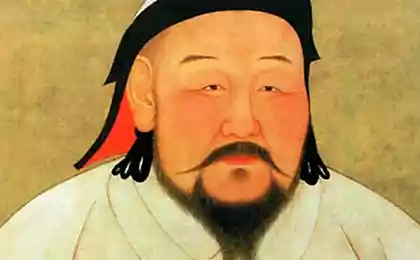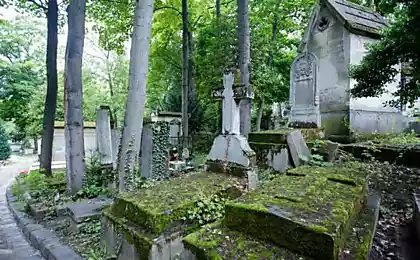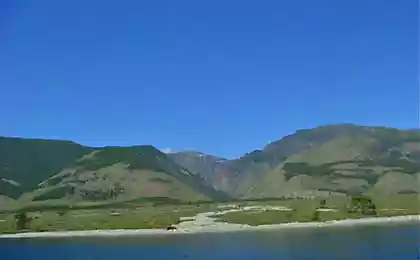984
Mystery of Genghis Khan's grave
However, on the death of the great ruler also remained mysterious uncertainty. Famous pilgrim Marco Polo wrote that Khan had died of wounds received as a result of getting poisoned arrow in the knee. Returning from Mongolia envoy of Pope Plano Carpini in 1247 reported that Khan was killed by lightning. Officially, however, it was believed that his death was related to the disease that occurred from a fall from his horse while hunting.
And in ancient Mongolian tradition, reason and does tragicomic: Khan, who at the time was already well over seventy, died from injuries allegedly inflicted teeth beauty. Whether in a fit of passion she had bitten him, or wanted to take revenge - is unknown. Kyurbeldishin Khatun was the wife of the Tangut ruler, and after the fall of the capital of the Tangut kingdom conqueror Genghis rightly cleaned all the land in their hands, and became captivated by the beauty of one of his many wives. Yes, that's a biting ...
With regard to the burial place of the same Marco Polo he said: "All the great rulers, descendants of Genghis Khan, you know, buried in a large mountain Altai, and wherever he died great sovereign of the Tatars, at least one hundred days to go before that mountain, it is brought to be buried . And this curiosity: when the body of the great Khans are to the mountain, every forty days, more or less, with the killing sword escort the body, but sentenced Go serve our Emperor! »
From different sources loomed and details of events culminating in 1227 - Genghis Khan's burial. Funeral procession with the remains left bend of the Yellow River (Huang He, on the territory of China) and went through the Gobi desert in the Karakorum, which attracts the Mongol nobility and heads of labor. On the way we istreblinlis all who could learn about the premature death of the supreme Khan.
On the appointed day, the remains of shamans dressed in ceremonial clothes, placed in a coffin. Then (for safety or for the difference?) The coffin has invested in four, one to another, and taken to Mount Burkhan Khaldun. She was supposed to be a place of eternal rest. And to no one disturbed, they killed all the slaves who performed pogrimelnye work and found security at remote locations from the grave. No one had to know where it is.
The goal was achieved. Over the years, the bushes and then trees and completely hidden slopes of the mountain massif Khentei, and no one could tell which of the mountains bore the name Burkhan Khaldun. And with the very name of the top of the clarity it was not. But the majority of versions about the whereabouts of the tomb of Genghis Khan led to the array Khentei.
It is not the highest in the range of Mongolia, does not exceed 2,800 m (in the Mongolian Altai top of Munch-Khairkhan Ula reaches 4362 m). Highlands is located in the central part of the country, and today has become a place of pilgrimage and quest of many expeditions.
A large area around one of the mountains in Khentei was declared sacred, no-penetration on pain of death. One of the Mongolian clans, named Darkhan, was entrusted to guard the sanctuary, and he continued to live there for 700 years, until it was forcibly evicted in the first half of the last century. The territory has come to desolation, and these once sacred places was only the howling of wolves.
The Japanese with their most advanced technology not found anything perceptible. What gave rise to one of the researchers noted: it is difficult to find a black cat in a dark room, especially if it's not there ...
But searchers were not appeased. It is developing a version of the burial of the Great Khan in place of his birth, on the river Onon. According to legend, the body of generals and brought here by building near Mount Delyun-Baldock dam, took the riverbed. On the bare rocky bottom set of rock crystal sarcophagus with the body of Khan, and then let the water through the old bed of the Onon.
To remember and visit IHI-Edzhen Horo in Ordaz, where yurts were allegedly the remains of the great conqueror, a famous Russian traveler GN Potanin. Buddhist monks every year arranges a big celebration in honor of Genghis Khan's yurt, where if in a silver reliquary are bone Khan. Previously, shamans were brought here casualties. No, not for nothing that there was a commandment - Do not make an idol ...
In 1998, a group led by the Buryats Chinggis Golboinom went in search of the burial place of the great Mongol. Before it clear that at the time Khan was driving on the left bank of the Selenga River to their homeland. He and his companions reached the Khamar-Daban and in the one of the tops have built about, and this mountain was named Burhan Gala-Uul. They gave the name and the surrounding peaks. Now known as the Baga Altan, called the Hut-Uul, meaning "mountain of the queen," and standing to the north - dubbed the Khan-Uul, whose place-name means "King Mountain."
Golboina Group, which was a surveyor and cartographer, and dowser, good luck. In the north-western slope of the Khamar-Daban structure was found, presumably considered to be about Genghis Khan, that is the place where shamans performed their rituals, worshiping the spirit of the great conqueror. About a kind of looks like a cairn of different sizes and shapes. Among them are many large boulders. The height is about about 15 meters in circumference, it is 50 m. First place is surrounded by a forest that burned several times, even though this area for more than eight centuries as horig declaring them-that is, the Great Mongol conservation area. It banned battue hunting and plowing land.
There are wonderful views of the snow capped ridges Sayan. Location is quite suitable for the disposal of "conquerors of the universe." But to say exactly where his grave because no one has, and can not. The search continues.
And in ancient Mongolian tradition, reason and does tragicomic: Khan, who at the time was already well over seventy, died from injuries allegedly inflicted teeth beauty. Whether in a fit of passion she had bitten him, or wanted to take revenge - is unknown. Kyurbeldishin Khatun was the wife of the Tangut ruler, and after the fall of the capital of the Tangut kingdom conqueror Genghis rightly cleaned all the land in their hands, and became captivated by the beauty of one of his many wives. Yes, that's a biting ...
With regard to the burial place of the same Marco Polo he said: "All the great rulers, descendants of Genghis Khan, you know, buried in a large mountain Altai, and wherever he died great sovereign of the Tatars, at least one hundred days to go before that mountain, it is brought to be buried . And this curiosity: when the body of the great Khans are to the mountain, every forty days, more or less, with the killing sword escort the body, but sentenced Go serve our Emperor! »
From different sources loomed and details of events culminating in 1227 - Genghis Khan's burial. Funeral procession with the remains left bend of the Yellow River (Huang He, on the territory of China) and went through the Gobi desert in the Karakorum, which attracts the Mongol nobility and heads of labor. On the way we istreblinlis all who could learn about the premature death of the supreme Khan.
On the appointed day, the remains of shamans dressed in ceremonial clothes, placed in a coffin. Then (for safety or for the difference?) The coffin has invested in four, one to another, and taken to Mount Burkhan Khaldun. She was supposed to be a place of eternal rest. And to no one disturbed, they killed all the slaves who performed pogrimelnye work and found security at remote locations from the grave. No one had to know where it is.
The goal was achieved. Over the years, the bushes and then trees and completely hidden slopes of the mountain massif Khentei, and no one could tell which of the mountains bore the name Burkhan Khaldun. And with the very name of the top of the clarity it was not. But the majority of versions about the whereabouts of the tomb of Genghis Khan led to the array Khentei.
It is not the highest in the range of Mongolia, does not exceed 2,800 m (in the Mongolian Altai top of Munch-Khairkhan Ula reaches 4362 m). Highlands is located in the central part of the country, and today has become a place of pilgrimage and quest of many expeditions.
A large area around one of the mountains in Khentei was declared sacred, no-penetration on pain of death. One of the Mongolian clans, named Darkhan, was entrusted to guard the sanctuary, and he continued to live there for 700 years, until it was forcibly evicted in the first half of the last century. The territory has come to desolation, and these once sacred places was only the howling of wolves.
The Japanese with their most advanced technology not found anything perceptible. What gave rise to one of the researchers noted: it is difficult to find a black cat in a dark room, especially if it's not there ...
But searchers were not appeased. It is developing a version of the burial of the Great Khan in place of his birth, on the river Onon. According to legend, the body of generals and brought here by building near Mount Delyun-Baldock dam, took the riverbed. On the bare rocky bottom set of rock crystal sarcophagus with the body of Khan, and then let the water through the old bed of the Onon.
To remember and visit IHI-Edzhen Horo in Ordaz, where yurts were allegedly the remains of the great conqueror, a famous Russian traveler GN Potanin. Buddhist monks every year arranges a big celebration in honor of Genghis Khan's yurt, where if in a silver reliquary are bone Khan. Previously, shamans were brought here casualties. No, not for nothing that there was a commandment - Do not make an idol ...
In 1998, a group led by the Buryats Chinggis Golboinom went in search of the burial place of the great Mongol. Before it clear that at the time Khan was driving on the left bank of the Selenga River to their homeland. He and his companions reached the Khamar-Daban and in the one of the tops have built about, and this mountain was named Burhan Gala-Uul. They gave the name and the surrounding peaks. Now known as the Baga Altan, called the Hut-Uul, meaning "mountain of the queen," and standing to the north - dubbed the Khan-Uul, whose place-name means "King Mountain."
Golboina Group, which was a surveyor and cartographer, and dowser, good luck. In the north-western slope of the Khamar-Daban structure was found, presumably considered to be about Genghis Khan, that is the place where shamans performed their rituals, worshiping the spirit of the great conqueror. About a kind of looks like a cairn of different sizes and shapes. Among them are many large boulders. The height is about about 15 meters in circumference, it is 50 m. First place is surrounded by a forest that burned several times, even though this area for more than eight centuries as horig declaring them-that is, the Great Mongol conservation area. It banned battue hunting and plowing land.
There are wonderful views of the snow capped ridges Sayan. Location is quite suitable for the disposal of "conquerors of the universe." But to say exactly where his grave because no one has, and can not. The search continues.





















